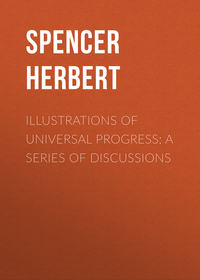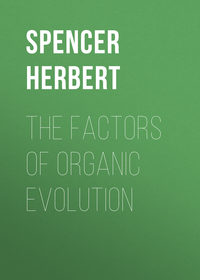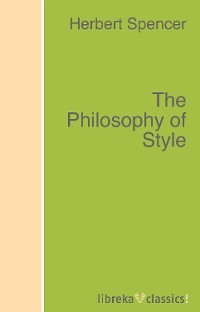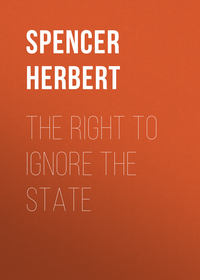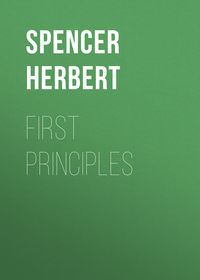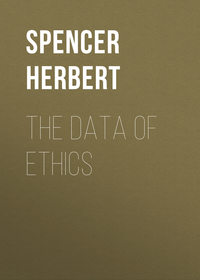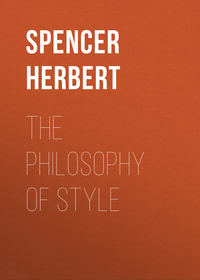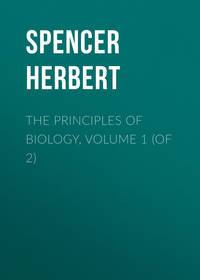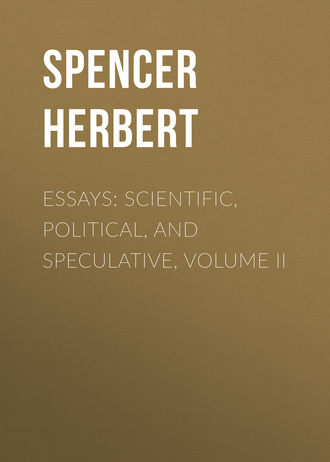 полная версия
полная версияEssays: Scientific, Political, and Speculative, Volume II
From our present point of view, then, it becomes obvious that the conception of a serial arrangement of the sciences is a vicious one. It is not simply that, as M. Comte admits, such a classification “will always involve something, if not arbitrary, at least artificial;” it is not, as he would have us believe, that, neglecting minor imperfections such a classification may be substantially true; but it is that any grouping of the sciences in a succession gives a radically erroneous idea of their genesis and their dependencies. There is no “one rational order among a host of possible systems.” There is no “true filiation of the sciences.” The whole hypothesis is fundamentally false. Indeed, it needs but a glance at its origin to see at once how baseless it is. Why a series? What reason have we to suppose that the sciences admit of a linear arrangement? Where is our warrant for assuming that there is some succession in which they can be placed? There is no reason; no warrant. Whence then has arisen the supposition? To use M. Comte’s own phraseology, we should say, it is a metaphysical conception. It adds another to the cases constantly occurring, of the human mind being made the measure of Nature. We are obliged to think in sequence; it is a law of our minds that we must consider subjects separately, one after another: therefore Nature must be serial – therefore the sciences must be classifiable in a succession. See here the birth of the notion, and the sole evidence of its truth. Men have been obliged when arranging in books their schemes of education and systems of knowledge, to choose some order or other. And from inquiring what is the best order, have fallen into the belief that there is an order which truly represents the facts – have persevered in seeking such an order; quite overlooking the previous question whether it is likely that Nature has consulted the convenience of book-making. For German philosophers, who hold that Nature is “petrified intelligence,” and that logical forms are the foundations of all things, it is a consistent hypothesis that as thought is serial, Nature is serial; but that M. Comte, who is so bitter an opponent of all anthropomorphism, even in its most evanescent shapes, should have committed the mistake of imposing upon the external world an arrangement which so obviously springs from a limitation of the human consciousness, is somewhat strange. And it is the more strange when we call to mind how, at the outset, M. Comte remarks that in the beginning “ toutes les sciences sont cultivées simultanément par les mêmes esprits ;” that this is “ inevitable et même indispensable ;” and how he further remarks that the different sciences are “ comme les diverses branches d’un tronc unique .” Were it not accounted for by the distorting influence of a cherished hypothesis, it would be scarcely possible to understand how, after recognizing truths like these, M. Comte should have persisted in attempting to construct “ une échelle encyclopédique .”
The metaphor which M. Comte has here so inconsistently used to express the relations of the sciences – branches of one trunk – is an approximation to the truth, though not the truth itself. It suggests the facts that the sciences had a common origin; that they have been developing simultaneously; and that they have been from time to time dividing and sub-dividing. But it fails to suggest the fact, that the divisions and sub-divisions thus arising do not remain separate, but now and again re-unite in direct and indirect ways. They inosculate; they severally send off and receive connecting growths; and the intercommunion has been ever becoming more frequent, more intricate, more widely ramified. There has all along been higher specialization, that there might be a larger generalization; and a deeper analysis, that there might be a better synthesis. Each larger generalization has lifted sundry specializations still higher; and each better synthesis has prepared the way for still deeper analysis.
And here we may fitly enter upon the task awhile since indicated – a sketch of the Genesis of Science, regarded as a gradual outgrowth from common knowledge – an extension of the perceptions by the aid of the reason. We propose to treat it as a psychological process historically displayed; tracing at the same time the advance from qualitative to quantitative prevision; the progress from concrete facts to abstract facts, and the application of such abstract facts to the analysis of new orders of concrete facts; the simultaneous advance in generalization and specialization; the continually increasing subdivision and reunion of the sciences; and their constantly improving consensus.
To trace out scientific evolution from its deepest roots would, of course, involve a complete analysis of the mind. For as science is a development of that common knowledge acquired by the unaided senses and uncultured reason, so is that common knowledge itself gradually built up out of the simplest perceptions. We must, therefore, begin somewhere abruptly; and the most appropriate stage to take for our point of departure will be the adult mind of the savage.
Commencing thus, without a proper preliminary analysis, we are naturally somewhat at a loss how to present, in a satisfactory manner, those fundamental processes of thought out of which science originates. Perhaps our argument may be best initiated by the proposition, that all intelligent action whatever depends upon the discerning of distinctions among surrounding things. The condition under which only it is possible for any creature to obtain food and avoid danger, is, that it shall be differently affected by different objects – that it shall be led to act in one way by one object, and in another way by another. In the lower orders of creatures this condition is fulfilled by means of an apparatus which acts automatically. In the higher orders the actions are partly automatic, partly conscious. And in man they are almost wholly conscious. Throughout, however, there must necessarily exist a certain classification of things according to their properties – a classification which is either organically registered in the system, as in the inferior creation, or is formed by conscious experience, as in ourselves. And it may be further remarked, that the extent to which this classification is carried, roughly indicates the height of intelligence – that, while the lowest organisms are able to do little more than discriminate organic from inorganic matter; while the generality of animals carry their classifications no further than to a limited number of plants or creatures serving for food, a limited number of beasts of prey, and a limited number of places and materials; the most degraded of the human race possess a knowledge of the distinctive natures of a great variety of substances, plants, animals, tools, persons, &c.; not only as classes but as individuals.
What now is the mental process by which classification is effected? Manifestly it is a recognition of the likeness or unlikeness of things, either in respect of their sizes, colours, forms, weights, textures, tastes, &c., or in respect of their modes of action. By some special mark, sound, or motion, the savage identifies a certain four-legged creature he sees, as one that is good for food, and to be caught in a particular way; or as one that is dangerous; and acts accordingly. He has classed together all the creatures that are alike in this particular. And manifestly in choosing the wood out of which to form his bow, the plant with which to poison his arrows, the bone from which to make his fish-hooks, he identifies them through their chief sensible properties as belonging to the general classes, wood, plant, and bone, but distinguishes them as belonging to sub-classes by virtue of certain properties in which they are unlike the rest of the general classes they belong to; and so forms genera and species.
And here it becomes manifest that not only is classification carried on by grouping together in the mind things that are like; but that classes and sub-classes are formed and arranged according to the degrees of unlikeness. Things strongly contrasted are alone distinguished in the lower stages of mental evolution; as may be any day observed in an infant. And gradually as the powers of discrimination increase, the strongly-contrasted classes at first distinguished, come to be each divided into sub-classes, differing from each other less than the classes differ; and these sub-classes are again divided after the same manner. By the continuance of which process, things are gradually arranged into groups, the members of which are less and less unlike; ending, finally, in groups whose members differ only as individuals, and not specifically. And thus there tends ultimately to arise the notion of complete likeness. For manifestly, it is impossible that groups should continue to be subdivided in virtue of smaller and smaller differences, without there being a simultaneous approximation to the notion of no difference.
Let us next notice that the recognition of likeness and unlikeness, which underlies classification, and out of which continued classification evolves the idea of complete likeness – let us next notice that it also underlies the process of naming , and by consequence language. For all language consists, at the outset, of symbols which are as like to the things symbolized as it is practicable to make them. The language of signs is a means of conveying ideas by mimicking the actions or peculiarities of the things referred to. Verbal language also, in its first stage, is a mode of suggesting objects or acts by imitating the sounds which the objects make, or with which the acts are accompanied. Originally these two languages were used simultaneously. It needs but to watch the gesticulations with which the savage accompanies his speech – to see a Bushman dramatizing before an audience his mode of catching game – or to note the extreme paucity of words in primitive vocabularies; to infer that in the beginning, attitudes, gestures, and sounds, were all combined to produce as good a likeness as possible of the things, animals, persons, or events described; and that as the sounds came to be understood by themselves the gestures fell into disuse: leaving traces, however, in the manners of the more excitable civilized races. But be this as it may, it suffices simply to observe, how many of the words current among barbarous peoples are like the sounds appertaining to the things signified; how many of our own oldest and simplest words have the same peculiarity; how children habitually invent imitative words; and how the sign-language spontaneously formed by deaf mutes is based on imitative actions – to be convinced that the notion of likeness is that from which the nomenclature of objects takes its rise. Were there space we might go on to point out how this law of likeness is traceable, not only in the origin but in the development of language; how in primitive tongues the plural is made by a duplication of the singular, which is a multiplication of the word to make it like the multiplicity of the things; how the use of metaphor – that prolific source of new words – is a suggesting of ideas which are like the ideas to be conveyed in some respect or other; and how, in the copious use of simile, fable, and allegory among uncivilized races, we see that complex conceptions which there is no direct language for, are rendered, by presenting known conceptions more or less like them.
This view is confirmed, and the predominance of this notion of likeness in primitive thought further illustrated, by the fact that our system of presenting ideas to the eye originated after the same fashion. Writing and printing have descended from picture-language. The earliest mode of permanently registering a fact was by depicting it on a skin and afterwards on a wall; that is – by exhibiting something as like to the thing to be remembered as it could be made. Gradually as the practice grew habitual and extensive, the most frequently repeated forms became fixed, and presently abbreviated; and, passing through the hieroglyphic and ideographic phases, the symbols lost all apparent relation to the things signified: just as the majority of our spoken words have done.
Observe, again, that the same thing is true respecting the genesis of reasoning. The likeness which is perceived to exist between cases, is the essence of all early reasoning and of much of our present reasoning. The savage, having by experience discovered a relation between a certain object and a certain act, infers that the like relation will be found in future. And the expressions we use in our arguments – “ analogy implies,” “the cases are not parallel ,” “by parity of reasoning,” “there is no similarity ,” – show how constantly the idea of likeness underlies our ratiocinative processes. Still more clearly will this be seen on recognizing the fact that there is a close connexion between reasoning and classification; that the two have a common root; and that neither can go on without the other. For on the one hand, it is a familiar truth that the attributing to a body in consequence of some of its properties, all those other properties in virtue of which it is referred to a particular class, is an act of inference. And, on the other hand, the forming of a generalization is the putting together in one class, all those cases which present like relations; while the drawing a deduction is essentially the perception that a particular case belongs to a certain class of cases previously generalized. So that as classification is a grouping together of like things; reasoning is a grouping together of like relations among things. Add to which, that while the perfection gradually achieved in classification consists in the formation of groups of objects which are completely alike; the perfection gradually achieved in reasoning consists in the formation of groups of cases which are completely alike.
Once more we may contemplate this dominant idea of likeness as exhibited in art. All art, civilized as well as savage, consists almost wholly in the making of objects like other objects; either as found in Nature, or as produced by previous art. If we trace back the varied art-products now existing, we find that at each stage the divergence from previous patterns is but small when compared with the agreement; and in the earliest art the persistency of imitation is yet more conspicuous. The old forms and ornaments and symbols were held sacred, and perpetually copied. Indeed, the strong imitative tendency notoriously displayed by the lowest human races – often seeming to be half automatic, ensures among them a constant reproducing of likenesses of things, forms, signs, sounds, actions and whatever else is imitable; and we may even suspect that this aboriginal peculiarity is in some way connected with the culture and development of this general conception, which we have found so deep and wide-spread in its applications.
And now let us go on to consider how, by a further unfolding of this same fundamental notion, there is a gradual formation of the first germs of science. This idea of likeness which underlies classification, nomenclature, language spoken and written, reasoning, and art; and which plays so important a part because all acts of intelligence are made possible only by distinguishing among surrounding things, or grouping them into like and unlike; – this idea we shall find to be the one of which science is the especial product. Already during the stage we have been describing, there has existed qualitative prevision in respect to the commoner phenomena with which savage life is familiar; and we have now to inquire how the elements of quantitative prevision are evolved. We shall find that they originate by the perfecting of this same idea of likeness – that they have their rise in that conception of complete likeness which, as we have seen, necessarily results from the continued process of classification.
For when the process of classification has been carried as far as it is possible for the uncivilized to carry it – when the animal kingdom has been grouped not merely into quadrupeds, birds, fishes, and insects, but each of these divided into kinds – when there come to be classes, in each of which the members differ only as individuals, and not specifically; it is clear that there must frequently occur an observation of objects which differ so little as to be indistinguishable. Among several creatures which the savage has killed and carried home, it must often happen that some one, which he wished to identify, is so exactly like another that he cannot tell which is which. Thus, then, there originates the notion of equality. The things which among ourselves are called equal – whether lines, angles, weights, temperatures, sounds or colours – are things which produce in us sensations which cannot be distinguished from each other. It is true that we now apply the word equal chiefly to the separate traits or relations which objects exhibit, and not to those combinations of them constituting our conceptions of the objects; but this limitation of the idea has evidently arisen by analysis. That the notion of equality originated as alleged, will, we think, become obvious on remembering that as there were no artificial objects from which it could have been abstracted, it must have been abstracted from natural objects; and that the various families of the animal kingdom chiefly furnish those natural objects which display the requisite exactitude of likeness.
The experiences out of which this general idea of equality is evolved, give birth at the same time to a more complex idea of equality; or, rather, the process just described generates an idea of equality which further experience separates into two ideas – equality of things and equality of relations. While organic forms occasionally exhibit this perfection of likeness out of which the notion of simple equality arises, they more frequently exhibit only that kind of likeness which we call similarity; and which is really compound equality. For the similarity of two creatures of the same species but of different sizes, is of the same nature as the similarity of two geometrical figures. In either case, any two parts of the one bear the same ratio to one another, as the homologous parts of the other. Given in a species, the proportions found to exist among the bones, and we may, and zoologists do, predict from any one, the dimensions of the rest; just as, when knowing the proportions subsisting among the parts of a geometrical figure, we may, from the length of one, calculate the others. And if, in the case of similar geometrical figures, the similarity can be established only by proving exactness of proportion among the homologous parts – if we express this relation between two parts in the one, and the corresponding parts in the other, by the formula A is to B as a is to b; if we otherwise write this, A to B = a to b; if, consequently, the fact we prove is that the relation of A to B equals the relation of a to b; then it is manifest that the fundamental conception of similarity is equality of relations. With this explanation we shall be understood when we say that the notion of equality of relations is the basis of all exact reasoning. Already it has been shown that reasoning in general is a recognition of likeness of relations; and here we further find that while the notion of likeness of things ultimately evolves the idea of simple equality, the notion of likeness of relations evolves the idea of equality of relations: of which the one is the concrete germ of exact science, while the other is its abstract germ. Those who cannot understand how the recognition of similarity in creatures of the same kind, can have any alliance with reasoning, will get over the difficulty on remembering that the phenomena among which equality of relations is thus perceived, are phenomena of the same order and are present to the senses at the same time; while those among which developed reason perceives relations, are generally neither of the same order, nor simultaneously present. And if, further, they will call to mind how Cuvier and Owen, from a single part of a creature, as a tooth, construct the rest by a process of reasoning based on this equality of relations, they will see that the two things are intimately connected, remote as they at first seem. But we anticipate. What it concerns us here to observe is, that from familiarity with organic forms there simultaneously arose the ideas of simple equality , and equality of relations.
At the same time, too, and out of the same mental processes, came the first distinct ideas of number. In the earliest stages, the presentation of several like objects produced merely an indefinite conception of multiplicity; as it still does among Australians, and Bushmen, and Damaras, when the number presented exceeds three or four. With such a fact before us we may safely infer that the first clear numerical conception was that of duality as contrasted with unity. And this notion of duality must necessarily have grown up side by side with those of likeness and equality; seeing that it is impossible to recognize the likeness of two things without also perceiving that there are two. From the very beginning the conception of number must have been, as it is still, associated with likeness or equality of the things numbered; and for the purposes of calculation, an ideal equality of the things is assumed. Before any absolutely true numerical results can be reached, it is requisite that the units be absolutely equal. The only way in which we can establish a numerical relationship between things that do not yield us like impressions, is to divide them into parts that do yield us like impressions. Two unlike magnitudes of extension, force, time, weight, or what not, can have their relative amounts estimated, only by means of some small unit that is contained many times in both; and even if we finally write down the greater one as a unit and the other as a fraction of it, we state, in the denominator of the fraction, the number of parts into which the unit must be divided to be comparable with the fraction. It is, indeed, true, that by a modern process of abstraction, we occasionally apply numbers to unequal units, as the furniture at a sale or the various animals on a farm, simply as so many separate entities; but no exact quantitative result can be brought out by calculation with units of this order. And, indeed, it is the distinctive peculiarity of the calculus in general, that it proceeds on the hypothesis of that absolute equality of its abstract units, which no real units possess; and that the exactness of its results holds only in virtue of this hypothesis. The first ideas of number must necessarily then have been derived from like or equal magnitudes as seen chiefly in organic objects; and as the like magnitudes most frequently observed were magnitudes of extension, it follows that geometry and arithmetic had a simultaneous origin.
Not only are the first distinct ideas of number co-ordinate with ideas of likeness and equality, but the first efforts at numeration display the same relationship. On reading accounts of savage tribes, we find that the method of counting by the fingers, still followed by many children, is the aboriginal method. Neglecting the several cases in which the ability to enumerate does not reach even to the number of fingers on one hand, there are many cases in which it does not extend beyond ten – the limit of the simple finger notation. The fact that in so many instances, remote, and seemingly unrelated nations, have adopted ten as their basic number; together with the fact that in the remaining instances the basic number is either five (the fingers of one hand) or twenty (the fingers and toes); of themselves show that the fingers were the original units of numeration. The still surviving use of the word digit , as the general name for a figure in arithmetic, is significant; and it is even said that our word ten (Sax. tyn; Dutch, tien; German, zehn) means in its primitive expanded form two hands. So that, originally, to say there were ten things, was to say there were two hands of them. From all which evidence it is tolerably clear that the earliest mode of conveying the idea of a number of things, was by holding up as many fingers as there were things; that is, by using a symbol which was equal , in respect of multiplicity, to the group symbolized. For which inference there is, indeed, strong confirmation in the statement that our own soldiers spontaneously adopted this device in their dealings with the Turks during the Crimean war. And here it should be remarked that in this re-combination of the notion of equality with that of multiplicity, by which the first steps in numeration are effected, we may see one of the earliest of those inosculations between the diverging branches of science, which are afterwards of perpetual occurrence.




